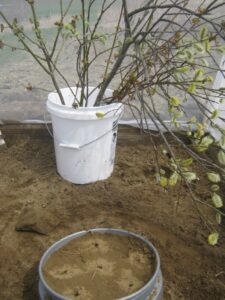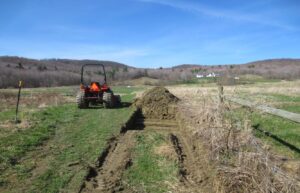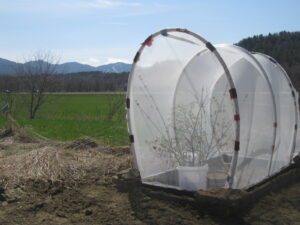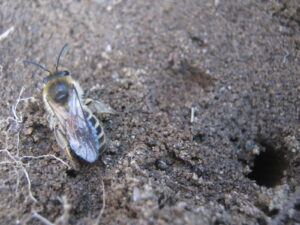Final report for FNE17-871
Project Information
We wanted to see if it was possible to establish populations of native bees (Colletes) for orchard pollination services by providing typical ground nesting habitat (sandy, south facing slopes) and caging bees for several days to entice them to begin nesting. Sand pits were established in 3 locations on two farms. One nesting area was already a sandy slope where we removed vegetation and the two others were created by digging a pit and filling it with sand. We tried sourcing bees by digging pupae and collecting adults from known nesting aggregations. Adult bees captured were brought back to our home farm and released near the ground nesting sites or caged with floral resources for 3 days. Pupae dug in the fall were nearly impossible to find and it was difficult and time consuming to collect adult bees. We did see one nesting hole in a plot where pupae collected in 2016 were buried, but that nest was only active for a few days. 2017 was our best year for collecting adult bees and we caged 20 females and 5 males over one ground nesting plot for three days. 5 female and 2 male bees were caged over another plot for 24 hours. In 2018 and 2019 only a few adult bees were captured. At the time of this report there were no signs of nesting activity, so we were disappointed in the results but will keep monitoring the sites. Our outreach to the general public, farmers and service providers included an on-farm field day and we have given several presentations regarding the plight of native pollinators and the importance of providing habitat, both floral resources and nesting sites to enhance their populations.
The goal of this project is to improve native bee pollination services in Northeastern orchards. We
want to know if it is possible to establish and manage aggregations of ground nesting bees, especially Colletes species. If one of our proposed methods proves successful, other farmers will be able to copy the model. The new populations of bees on our farm could also serve as a source of bees for other fruit farms. We now propose to try three different methods to establish populations in three different orchard sites, two with sandy loam soil and one with silty loam soil. These methods will be 1) creating suitable ground nesting environment by removing vegetation from habitat patches around all three orchards, and bringing in sand to an area of the silty loam based orchard, to see if bees will move in naturally, 2) creating suitable ground nesting environments in both orchards and caging within the nesting area newly emerged and captured adult bees, 3) creating suitable ground nesting environments in both orchards and seeding them in the fall with bee pupae dug from other heavily populated areas that we know about.
Pollinator populations are in decline and fruit growers can no longer take their services for granted.
Relying solely on honeybees for pollination of spring flowering crops is risky due to hive rental supply issues and potential adverse weather during bloom. Native species, including Colletes inaequalis, have been shown to be effective orchard pollinators. Here in the Northeast, Colletes bees are some of the first to emerge in the spring and are well adapted to adverse conditions. They can form large aggregations of hundreds of bees nesting in sandy soils, yet they have not been managed for pollination services. Another type of native, ground nesting bee, the alkali bee (Nomia melanderi), is used for pollination of alfalfa in the western U.S. and farmers have become adept at creating nesting conditions for them. We propose to take a similar approach with Colletes.
Cooperators
- - Technical Advisor (Educator and Researcher)
Research




In April 2017, we tried three different methods to establish a population of ground nesting bees on one farm as opposed to the three orchards planned. We were not able to find sufficient numbers of overwintering cocoons or adults to try our methods in three different orchards. From our experiences trying to source wild bees, we adapted our methods to depending on freshly caught adult bees from aggregation sites as an establishment strategy and focused on working at The Farm Between.
The three methods trialed at The Farm Between were:
1) created a suitable ground nesting environment by removing vegetation from a habitat patch
in an orchard and added 5 previously dug pupae from fall 2016, 2) created a vegetation free habitat patch and added 5 female and two male adults caged for 24 hours, 3) dug a pit and brought in sand to an area of a silty loam based orchard, then caged within the nesting area 20 female and 5 male newly emerged and captured adult bees along with floral resources for three days. Artificial holes were created with a pencil to perhaps encourage digging and to provide shelter at night. Bees did use them for shelter.
In November 2017, John spent 2 hours digging for pupae in the area where he had captured adults in the spring. None were found.
In 2018, from Mid April through May, all three new habitat sites were monitored for Colletes emergence. No evidence of nesting was found.
The adult populations at our collecting sites were down in 2018, as only 6 adults (4 females and 2 males) were collected in 2, 3 hour sessions. This lack of bees made it impossible to carry out our plans to seed new habitat patches with adults. The 6 collected bees were brought back to The Farm Between and released near the sand pit.
A new 144 ft2 sand patch habitat was installed at LSF Orchard in Fletcher, VT in July 2018. The depth of sand was 2 feet. This was done on a west facing slope near a newly installed orchard.
In the last week of April 2019, 5 female and 2 male Colletes bees were caught and caged on the constructed sand pit at The Farm Between for 3 days before the screenhouse was taken off. No signs of nesting were observed.
We were not able to collect enough adults in 2019 to cage them on the newly constructed patch at LSF Orchard. The new patch along with the habitat patches at The Farm Between were monitored in 2019 for any nesting activity and none was found.
Unfortunatey, none of the trials for establishing ground nesting bees were successful. The bees that were caged for 3 days showed signs of digging nesting holes in the sand provided in 2017. There was no clear evidence of bee activity in the other 2 trials. Not finding pupae in the fall in an area that was marked as an aggregation was discouraging. We will now focus on collecting newly emerged spring adults as a way to innoculate new orchards. We hope to collect enough bees in 2018 to try our 3 day caged adult method in 3 different orchards.
On May 5, 2018 one emergence hole and one adult Colletes female was observed it Site 1 (where the vegetation had been removed and 5 pupae buried the previous spring). After a few days the hole was no longer seen. Unfortunately that was the only nesting activity that we saw in 2018. We did see adults flying and visiting willow and apple flowers during bloom. However, we couldn't determine where they were coming from. There was no clear nesting establishment in 2018.
In 2018, adult bees were increasingly difficult to collect, so there was no caging and no nesting. The few bees that were caught and caged in 2019 did not show any nesting behavior.
The results were discouraging. Apparently it is not easy to start a new population by inoculating bees into a new habitat. It was also interesting to see that no new populations were observed in newly created habitats. 'Build it and they will come' did not hold true in this case.
There is a population of Colletes bees at The Farm Between as we observe them foraging on different plant species each spring. We have never seen where they are nesting though.
Over the course of three seasons, we tried various methods to start new nesting populations of the native Colletes bee. We cleared vegetation from existing south facing sandy slopes, and created new sand pits where there were none. We caught adult bees from other locations and screened them over sand pits for three days (with floral resources to feed on) in 2017 and 2019. It was time consuming to collect adult bees and digging pupae in the fall was not productive. One adult overwintered successfully in 2018, but did not finish nesting.
We did notice that there was a pre-existing population of Colletes at The Farm Between foraging on different spring blooms. We were not able to determing where they were nesting though.
Our conclusion is that it is not as simple as we thought to manipulate these bees. We will continue to maintain and monitor the sand patches that we have created to see what happens to them over time. A tarp will be used during the late summer to kill weeds and then be taken off in April before any bees are flying. We will continue to enhance our floral resources to make sure that there are plenty of spring blooming plants to support our existing population.
Education & Outreach Activities and Participation Summary
Participation Summary:
The results of our study didn't warrant any publications or articles since we didn't have success with any of our techniques for seeding new populations. However we did talk about our SARE grant and show our work to various groups over the life of the grant.
Education and outreach activities included presentations on creating nesting habitat for native bees at the Ecological Landscaping Association Annual Meeting (2018) and the research was mentioned in other talks given. On farm demonstrations on creating native bee habitat were conducted for multiple groups from the UVM Farmer Training Program in 2018 (20 farmer/trainer in total) and agroecology field trips from the University of Vermont, Sterling College, and Saint Michael's College (approx 70 students in total). A 'Pesticides and Pollinators' Farm Tour and Panel Discussion was held (9/9/18) and was attended by approximately 8 farmers and 6 agricultural service providers who were all given a tour that included our SARE work.
Learning Outcomes
We were humbled by the difficulty in manipulating these native bee populations. We have found however, that all the farmers that we interacted with are interested in the plight of native bees and were able to educate them about their importance and life cycles. This increased their awareness of management practices that could be detrimental to ground nesting bees, especially deep tillage and using insecticides that persist in the soil.
Project Outcomes
While the experiment didn't work out as hoped, I developed a better appreciation for the importance of managing the environment for the bees that are already present on our farms, because it is difficult to get new populations started.
It was a good try! The adult bees did not take readily to being transported to a new location. The few pupae that we buried did have an emerged and nesting bee for a few days, but finding pupae was nearly impossible. Perhaps a better pupae location and digging strategy would have improved our results. The answer to the question of establishing new populations was: not easily as least. We will continue to maintain and monitor our sand patches to observe whether new bees populate them over the years. I think this research could be useful to anyone else contemplating the idea of manipulating ground nesting bee populations. We will continue to stress the importance of creating habitat for pollinators in our future educational work, but with less emphasis on creating new ground nesting habitat as a simple solution.